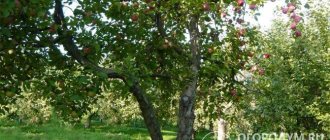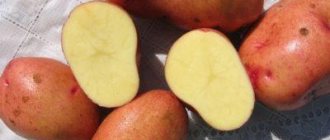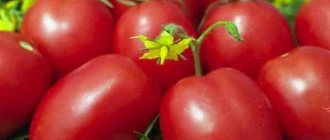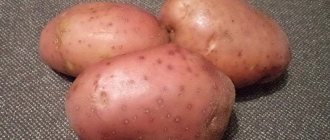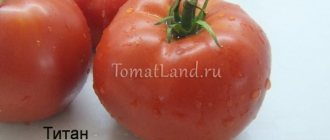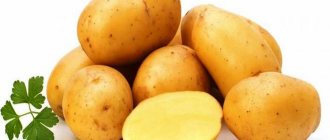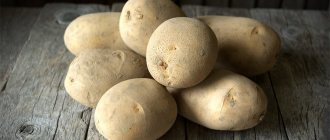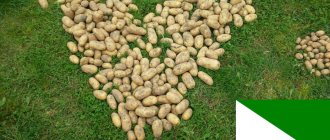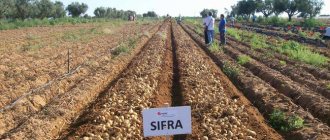What kind of potato is this?
American is an old potato variety, bred in 1861. Its creator is the American breeder Albert Bresee.
In 1931, the variety was included in the Russian State Register. At that time, it was actively grown on collective and state farms in Moscow, Ukraine and all countries of the USSR.
The American is also known under the names : Early Rose, Latvian, Dovzhik, Olkhovka, Skorospelka, Yanovka, Turka, Monthly.
Distinctive features
The peculiarity of American is its excellent taste characteristics . This variety is recognized as the standard of potato taste. It has tender, slightly sweet and crumbly flesh. It does not fall apart when cooked, but at the same time it produces a tasty and airy puree.
Despite the fact that this variety is about 150 years old, its yield exceeds that of many others. One plant produces up to 15 large tubers .
The appearance of the root crop is also attractive. The potato has an oblong, flattened shape , thin light pink skin. The variety is early ripening. The first potatoes are ready for harvest in July.
A negative feature of the American woman is considered to be low immunity. This variety is resistant to many nightshade diseases, but is susceptible to late blight and bacterial canker .
History of breeding
The USA is the birthplace of this variety. Refers to an old variety obtained through selection. The author of The American is Albert Bresee. A scientific researcher discovered a new type of potato in 1861.
The hybrid was obtained as a result of spontaneous pollination of seedlings. The planting materials were potato seeds of the Chilean pomegranate variety. The first attempt at breeding turned out to be a success. Albert managed to get a delicious and healthy root vegetable.
Today, the State Register recommends growing the variety in the Central region of Russia. With proper care, the American is able to adapt to harsher climates. Residents of Siberia reap good harvests.
General characteristics of the plant
American is still the most popular potato variety . Due to its high taste characteristics and excellent yields, many gardeners prefer it to many more modern options.
Description of the variety is presented in the table:
| Parameter | Index |
| Ground part of the plant | Medium-sized bush (up to 70 cm). Abundantly leafy. The stems are powerful with a purple (anthocyanin) tint. The leaves are thin, small in size, slightly dissected. Inflorescences are semi-spreading. Short peduncles and pedicels are purple in color. The calyxes are well pubescent, leaf-shaped tips, anthocyanin in color. The corollas are white and small in size. Berries are formed extremely rarely. |
| Roots | Medium size. One tuber weighs from 80 to 150 g. Elongated oval shape, aligned, flattened on both sides. The skin color is light pink with brighter spots. There are many eyes, but they rather resemble pigmentation, since they do not grow into the flesh. The flesh is white, in some cases there are purple spots. The taste is rich, slightly sweet. During heat treatment it becomes crumbly and does not change color. Starch content - up to 17.5%. The sprouts are red or purple. |
| Ripening time | Early ripening. It takes 70–80 days from sowing the root crop to harvesting. |
| Productivity | High. Up to 40 tons are collected from 1 hectare. One bush produces from 5 to 15 tubers. |
| Transportability | High. Tubers can be stored for up to a year without losing their taste. This figure is equivalent to 97%. |
| Immunity to disease | Is immune to most nightshade diseases. There is a possibility of late blight and bacterial cancer. |
| Features of cultivation | Recommended for cultivation in the central and southern parts of the country (Voronezh, Belgorod, Kursk, Moscow regions, etc.). |
Agricultural technology American
Potatoes are grown using the seedless method . Tubers are planted immediately in open ground. In cool regions, the crop is first grown under film.
In the southern regions, potatoes are sown in the ground in early April. In cities with a temperate climate - in the second half.
Advice! Planting material is prepared a month before it is placed in the ground.
Preparation of planting material
To speed up the emergence of seedlings and protect plants from diseases and negative environmental factors, planting material is prepared in advance .
This procedure consists of several stages:
- For planting, select tubers without damage. They should be the size of a chicken egg. Selected root vegetables are left at room temperature for 3 days.
- After this they are disinfected. Wash with a solution prepared from 1 tsp. copper sulfate and 3 liters of water. Then the planting material is dried for 5 days.
- The potatoes are washed in a solution prepared from 3 liters of water and half a teaspoon of boric acid. The tubers are left to dry for 5 days.
- To stimulate growth, planting material is washed in “Solution” or “Superagro”. To prepare it, 1 tsp. The drug is added to 3 liters of water. The tubers are dried again for 5 days.
Other potato varieties:
Consistently productive potato variety Impala
Potatoes "Crimean Rose" for hot climates
Early table potato variety "Tiras"
Then the potatoes are stored for a month at a temperature of +17°C . The room is ventilated daily, and the tubers are sprayed with water at room temperature from a spray bottle.
When many sprouts form on the tubers (after a month), they are placed in a room with a temperature of +10°C for 2 days. After this they are ready to disembark.
Advice! To save planting material, some gardeners cut the sprouted tubers into several parts. If you do this, make sure there are sprouts on each piece.
Soil preparation and planting potatoes
Potato beds begin to be prepared in the fall. Choose a plot of the garden that is in full sun. No other nightshade crops should grow on it for the past 2 years. They are not planted near potato beds either.
In autumn, the soil is dug up to a depth of at least 20 cm . Then they level it with a rake and remove all the larvae from it.
Fertilizers are applied to the beds. 6 kg of cow dung or humus is scattered on each square meter. If the acidity of the soil is increased, scatter 1 tbsp. dry lime per 1 m². Fertilizers are thoroughly mixed with the soil.
Advice! After harvesting in August or September, it is recommended to sow in an area where potatoes, legumes, oats or rye will be grown. This will increase the nutritional value of the soil.
In the spring, the beds are dug up again . They are cleared of weeds and watered with copper sulfate. Apply 3 tbsp per 1 m². l. superphosphate and 1 tbsp. l. potassium sulfate.
Holes 10 cm deep are dug in rows in a checkerboard pattern. The distance between the rows should be 35 cm, and between the recesses - 60 cm.
A handful of ash and onion peels are poured into each hole. Many gardeners also send long-acting complex mineral fertilizers there.
Place 1 tuber in each hole. They are covered with earth without compacting it. The beds are watered with warm water.
Basic rules of care
Before the first shoots appear, the potato beds are loosened 2 times , removing all weeds. As a result, the earthen crust is destroyed, which prevents the tubers from rotting.
Potato beds are watered as the soil dries . Use settled warm water. After each watering and rainfall, the soil is loosened. This is done carefully so as not to damage the tubers, thereby increasing the risk of infection. During the loosening process, the beds are cleared of weeds.
Potatoes are hilled twice during the season . The first time is when the bushes reach a height of 20 cm, and repeat after 2-3 weeks. This promotes the formation of new roots and an increase in the number of tubers.
Advice! After heavy rains, additional loosening will be required.
During the entire period of growing potatoes, they are fed three times according to the following scheme :
- The first fertilizing is applied 2 weeks after emergence. To do this, use a product prepared from 10 liters of water and 1 kg of chicken droppings or rotted cow manure.
- After the formation of the first bud, fertilizer is applied a second time. To do this, prepare a remedy from 1 tbsp. wood ash and 1 bucket of water.
- The last time the plants are fed is during the period of mass flowering. To do this, pour 0.5 liters of a solution prepared from 10 liters of water, 2 tbsp. mullein and 2 tbsp. l superphosphate.
Important! Before each application of fertilizer, the beds are watered with clean warm water.
Tips from gardeners
To avoid problems when growing potatoes, use the advice of experienced gardeners :
- Agree with your neighbors to process and collect the Colorado potato beetle from all nightshade plants on the same day. In this case, a repeated “invasion” of insects will not happen.
- Water and feed potatoes early in the morning or at sunset. If you do this when the sun is active, the tubers will simply “cook” in the soil.
- American bushes grow strongly, which increases the risk of plant infection with late blight. Remove a few leaves from the bottom of the bush.
- To get the largest possible tubers, it is recommended to apply foliar fertilizing 10 days before harvest. To do this, the bushes are simply sprayed with superphosphate.
- Mulch potato beds and soil between rows. This will protect the plants from diseases, pests and negative environmental factors.
- To provide the potatoes with optimal moisture, they are watered not manually, but using an automatic drip method.
- Mark the healthiest and most beautiful bushes with ribbons. It is from them that it is better to collect seed material.
Diseases and pests
American potatoes are resistant to most nightshade diseases , but some infections pose a danger to them:
- Late blight. The stems and leaves become covered with brown spots, which turn black over time and cause the plants to wither. The disease spreads to tubers, leading to their rotting. For prevention, potato bushes are sprayed with a solution of copper sulfate 2-3 times during the entire growing period. The disease cannot be treated; affected plants are removed and burned, and the soil is disinfected.
- Bacterial cancer . Dark formations resembling cauliflower grow from the eyes of potato roots. Such tubers are inedible. The disease cannot be treated. Affected plants are removed, and the soil on which they grew is disinfected.
Prevention will help you avoid contracting these dangerous diseases . It consists of disinfecting garden tools, soil and tubers, observing the rules of watering, hilling, and crop rotation.
Potatoes are often attacked by the Colorado potato beetle . Pests are simply collected from plants by hand. If there are a lot of them, then use chemicals, for example, “Barrier”.
Wireworm attacks potato tubers. It will not be possible to notice and neutralize it in a timely manner. In this case, prevention is important. It consists of mulching, using slightly acidic soils and planting onions between rows of potatoes.
Landing
Tubers or eyes are planted in heated soil in April or May, when the frosts end. To obtain tuber eyes, you need to prepare:
- Sort through the planting material, throw away spoiled, rotten and dried potatoes.
- Spread the remaining ones in a single layer on the floor in a well-lit room.
- Provide temperature +12-15 degrees.
- When sprouts begin to appear, treat with a growth stimulator (can be soaked in solution).
- Wipe a sharp knife with an antiseptic and carefully, so as not to break off the sprouts, cut the tubers into segments.
Sprouts with fragments of tubers are planted in nutritious loose soil according to the scheme 50 by 50 or 30 by 80.
The soil is prepared in the fall, dug up twice (in autumn and spring) to the depth of a spade bayonet. Both times, fertilizers are applied before digging; in the fall it is usually compost or humus, and in the spring it is superphosphate and urea.
Collection, storage and use of crops
The American potato harvest is already harvested in July . The fact that the root crops have reached their maximum size and are ready for harvesting will be indicated by the withered and yellowed ground part of the bush:
- It is recommended to dig up potato tubers not with a shovel, but with a pitchfork. This will reduce the amount of damage. Harvest only in dry weather.
- To separate the tops from the root crops, just shake them.
- The collected potatoes are laid out on newspaper and dried for 2-3 days. After this, the soil can be easily removed with a dry cloth.
- The tubers are sorted and carefully examined. Damaged copies cannot be stored. They need to be eaten first.
- Potato storage boxes are wiped with copper sulfate or a dark pink solution of potassium permanganate. The room is fumigated with sulfur.
- American is stored in a room with a humidity of no higher than 80% and a temperature of up to +5°C.
- During storage, the tubers are periodically sorted. Damaged copies must be removed.
American is a universal variety . It is suitable for boiling and frying. Some housewives claim that such root vegetables taste better when boiled or baked.
Advantages and disadvantages of the variety
Benefits of American Potatoes:
- high productivity;
- great taste;
- resistance to many diseases;
- ease of care;
- high shelf life and transportability;
- tubers do not degenerate for 20 years;
- early ripeness.
Among the disadvantages:
- lack of immunity to late blight and bacterial cancer;
- abundant green mass that attracts pests.
Useful video
Watch the video: American potatoes characteristics
In the table below you will find links to materials about potatoes with different ripening periods:
| Mid-season | Mid-early | Mid-late |
| Santana | Tiras | Melody |
| Desiree | Elizabeth | Lorch |
| Openwork | Vega | Margarita |
| Purple Haze | Romano | Son |
| Yanka | Lugovskoy | Lasunok |
| Tuscany | Tuleevsky | Aurora |
| Giant | Manifesto | Zhuravinka |
Farmer reviews
Reviews from gardeners indicate the high quality of Americana fruits .
Many of them grow this variety year after year. Alisa, Moscow : “My mother raised American. I, too, have not changed this variety for many years. Of course, he is not particularly resistant to disease. You have to regularly treat it with copper sulfate. I grow it because of its great taste. Any dish with it turns out simply excellent. I really like the flattened long fruits, just like in the photo. Convenient for stuffing with halves.”
Gleb, Voronezh : “I remember the taste of American from childhood. This is perhaps the most delicious and beautiful pink potato. I would like to grow it at home, but planting material is not easy to find. This year I found it at the grocery market. I planted it, let’s see what happens.”

